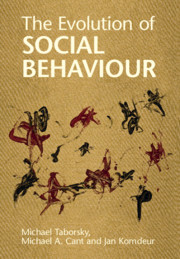2 - Non-interference Rivalry
Published online by Cambridge University Press: 30 July 2021
Summary
Competition for resources is the fundamental process generating selection on social behaviour. Individuals compete with family members, with other conspecifics, and with the members of other species for food, shelter and other resources that are essential for survival and reproduction. Conspecifics also compete for access to social partners and mates, and hence selection acting on strategies of social competition is particularly intense (West-Eberhard 1979). However, competition is not simply a repellent force in the lives of organisms, driving them apart; it is often a social attractor, bringing individuals together and setting the stage for social evolution. In particular, where resources such as food and mates are clumped in the environment or predictable in time, competition has the effect of drawing individuals together into aggregation and possible social interaction, selecting for strategies that maximize fitness by exploiting, parasitizing, following, or even cooperating with other individuals of the same or different species.
- Type
- Chapter
- Information
- The Evolution of Social Behaviour , pp. 35 - 66Publisher: Cambridge University PressPrint publication year: 2021



